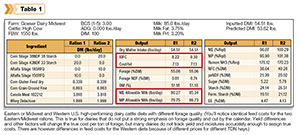Tax season is here and many of us are meeting with our accountants to summarize last year’s balance sheet and plan for 2013. We likely consider different ways to minimize tax implications on our business, planning ahead and investing in various areas of our business.
There are state and federal taxes that we plan around but also a lesser-known tax that we might not even know about – your forage tax. So what is your forage tax? Let’s get into it.
Several issues back ( Click here to view this article) we talked about what to expect from 2012 forage, finding that 2012 forage was slightly better-quality than 2011 across the U.S. We went on to examine rations that differed only in forage source and found less milk with 2011 forage.
This is the forage tax – less milk from the same pounds of forage. Less milk from the same amount of feed decreases feed conversion efficiency, increases your cost to produce a hundredweight of milk and effectively levies an additional tax on your business that is avoidable. Tables 1 and 2 illustrate the potential forage tax 
for both Eastern/Midwest and Western rations.
Click here or on the image at right to view it at full size in a new window.
The ration comparisons in Table 1 have the exact same pounds of ingredients but differ in milk production, feed conversion and IOFC ($8.22 vs. $9.30 and $6.72 vs. $8.01 for Eastern/Midwest and Western diets) due to higher-digestible 
forages. This example is real across many dairies and causes us to miss out on five or more pounds of milk per cow.
Click here or on the image at right to view it at full size in a new window.
Average feed quality (e.g., 150 RFQ haylage) doesn’t cut it anymore with shrinking margins. Here is the forage tax – and it can be steep – potentially more than $1 per cow per day revenue from the same pounds of feed. What could your dairy business do with another $1 per cow per day?
Many dairies are finding out about this tax after the fact, and this is why dairies are trending towards more intensive planning, field management and superior seed genetics to achieve higher digestibility.
Dairy producers that acknowledge the forage tax will plan ahead to get the biggest returns on their forage. Here is what your team needs to know and understand to improve forage digestibilities:
- Create a forage game plan and get everyone on the same page.
- What are the goals?
- We are talking about all of the following – moisture, feed quality and digestibility.
- Does everyone on your team understand the goals, and is the team in agreement?
- Adversity plan – what will the team do when adversity strikes?
- For example, what if there is rain in the forecast, but 50 percent of our acres are cut?
- Genetics for corn and harvest management for grass or alfalfa
- The major digestibility point of impact for corn is genetics.
- Environment has an impact and you can limit the best corn genetics through poor management, but seed corn is a top tool to change digestibility.
- Grass and alfalfa digestibility improve through harvest management.
- Monitor crop maturity in the field and throw the calendar out as a management tool.
- Different grass varieties have different digestibilities, but monitoring maturity is your top tool to change digestibility.
- Preserve your highly digestible forage.
- After planning for and harvesting in highly digestible forage, maintain that quality all the way to the feedbunk.
- Preservation takes energy and that energy comes from starch and sugars.
- Less sugar and starch equals less digestibility.
- Pack, seal and use inoculants to ferment your forages as quickly as possible to limit the starch and sugars digested by fermentation bacteria.
- Oxygen, yeasts and molds are the enemy.
- Limit oxygen’s impact by minimizing surface area exposed at feedout. Keep a clean face.
- Inoculants work, and they positively impact fermentation and performance.
- Ferment forage faster and more efficiently to preserve more sugar.
- Improve feed stability by reducing yeast and mold.
In summary, there are significant “forage tax” dollars on the table for your dairy business. Producers that have worked the past several years to improve forage quality have watched margins grow through improved digestibility. Improve your bottom line in 2013 and beyond by getting more milk out of a pound of your feed. PD
Goeser is the Director of Nutritional Research and Innovation with Rock River Laboratory, Inc.
References omitted due to space but are available upon request. Click here to email an editor.

-
Dr. John Goeser
- Director of Nutritional Research and Innovation
- Rock River Laboratory, Inc.






